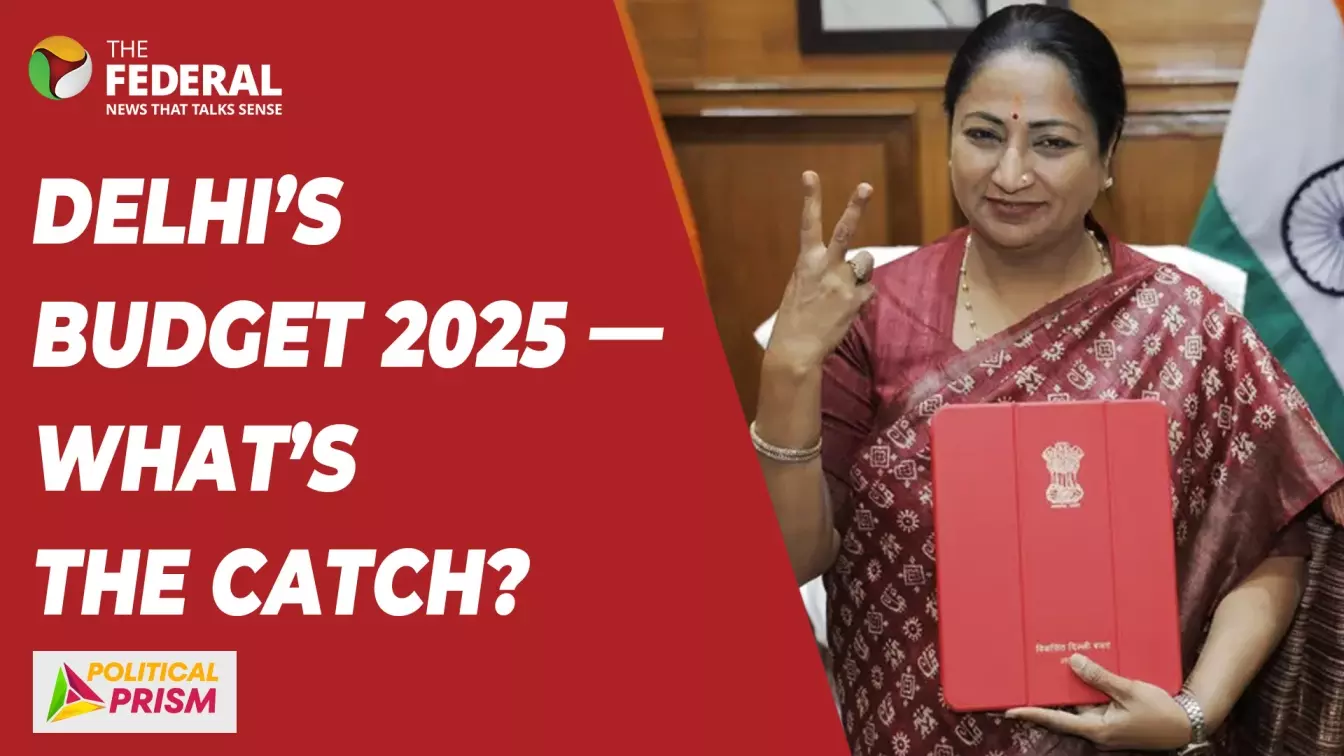
Delhi Budget 2025-26
Delhi Budget 2025-26: Rekha Gupta’s Rs 1 lakh crore plan for capital
Rekha Gupta’s Rs 1 lakh crore Delhi budget makes big promises on education, health, women and Yamuna. Can BJP deliver what AAP couldn’t?

In her debut budget as Delhi's Chief Minister and Finance Minister, Rekha Gupta unveiled a ₹1 lakh crore financial plan for the capital—its largest ever. This explainer by The Federal’s Puneet Nicholas Yadav breaks down what the budget means politically and economically. From reclaiming AAP’s governance turf to making big promises on health, education, and women’s welfare, the BJP’s first budget in Delhi in 27 years raises both expectations and questions.
This marks the largest-ever budget for Delhi, seeing a 31.5% jump over the previous year. But behind the numbers lies a sharp political narrative: reclaiming public sectors like education, health, and women’s welfare from the Aam Aadmi Party’s legacy while setting new markers for the BJP’s governance.
While the budget was rich in populist announcements, critics and observers have raised concerns about its lack of clarity on implementation and the political motives behind it.
Also read: Delhi CM presents Rs 1 lakh crore 'historic' budget with focus on 10 key areas
Budget focus areas
The major allocations in Gupta’s budget highlight education, women’s welfare, healthcare, and environmental clean-up as top priorities. These sectors were central to AAP’s political narrative over the past decade, and the BJP now seems keen to establish its footprint in the same spaces.
"Delhi government schools will get 7,000 smart classrooms, laptops for students, coaching support under the Vidya Shakti scheme, and major infrastructure upgrades," said Gupta. She alleged that AAP "deliberately failed Class 9 students" to manipulate board results.
For women, the budget promises ₹21,000 for expectant mothers, the creation of anganwadis, and working women’s creches. However, one of BJP’s biggest poll promises—₹2,500 monthly allowance to all women—now appears diluted. The allocated ₹5,100 crore suggests the scheme won’t be universal.
Health, pollution, and clean-up
Gupta also targeted the AAP over healthcare, accusing it of neglecting public hospitals. Her government has now committed to upgrading facilities and capacity-building in health institutions.
Cleaning the Yamuna and tackling air pollution are being positioned as flagship drives. The budget sets aside ₹500 crore for the Yamuna and over ₹9,000 crore for sanitation and drinking water efforts. An integrated command centre is also planned to monitor pollution levels.
However, skepticism remains. "Is ₹500 crore just a drop in a dirty Yamuna?" asked Gupta rhetorically, referencing how ₹50,000 crore was spent nationally over decades on cleaning the Ganga—with mixed results.
Also read: RSS to chip in as Delhi CM Rekha Gupta braces for first budget
Cultural showcase and tourism
In a bid to brand Delhi as a global cultural hub, Gupta proposed the city’s first international film festival. She also announced plans to revamp Old Delhi’s heritage zones like Chandni Chowk and Chawri Bazaar—areas with a sizable Muslim population.
Whether this translates into actual urban renewal or remains symbolic is something to watch.
Missing details, rising doubts
Despite the announcements, a critical gap lies in the roadmap for execution. For instance, eligibility details for schemes like the Mahila Samman Nidhi remain unspecified. “Survey and domicile certification will decide genuine Delhi beneficiaries,” Gupta said, a statement that raises eyebrows about possible exclusions—especially among migrants.
“There’s ambiguity around who qualifies as a ‘Delhiwala’. Could this mean exclusion for migrant workers and long-time residents not born in the city?” observers ask.
This approach—framing beneficiaries as “genuine” Delhi residents—could trigger debates on identity, exclusion, and urban migration.
Rural Delhi and the grameen pitch
Gupta also addressed rural Delhi—long overlooked in the capital’s urban-centric governance. She proposed reviving the Grameen Board and offering a ₹3,000 top-up to PM-Kisan beneficiaries.
Also read: Delhi Budget 2025-26: From health sector to water supply, here are major announcements
But again, execution remains the key concern. As Yadav summed it up, “Big-ticket promises are fine, but delivery is what will define this budget.”
Political strategy or governance shift?
The budget appears as much a political repositioning as it is a fiscal plan. By targeting AAP strongholds and pitching new schemes in their place, the BJP is looking to entrench itself in Delhi’s governance map.
But whether this budget becomes a turning point—or just campaign rhetoric wrapped in numbers—will depend on its rollout in the months to come.
(The content above has been generated using a fine-tuned AI model. To ensure accuracy, quality, and editorial integrity, we employ a Human-In-The-Loop (HITL) process. While AI assists in creating the initial draft, our experienced editorial team carefully reviews, edits, and refines the content before publication. At The Federal, we combine the efficiency of AI with the expertise of human editors to deliver reliable and insightful journalism.)

